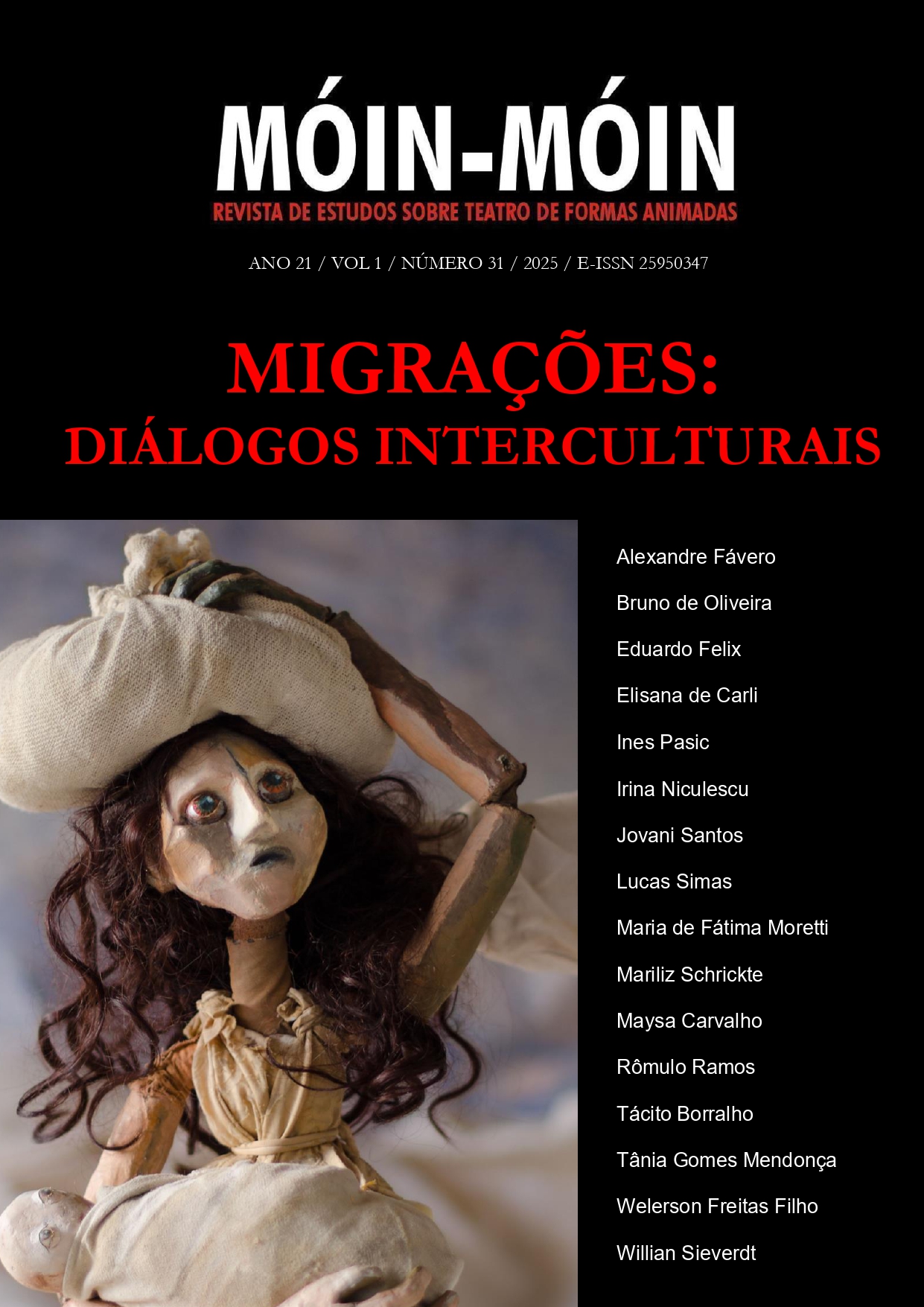Conde Ernesto Patrizio de Castiglione e suas companhias: a presença italiana no Teatro de Sombras no Brasil no século XIX.
DOI:
https://doi.org/10.5965/259503470131202505Palavras-chave:
teatro de sombras, Conde Ernesto Patrizinho, Brasil oitocentistaResumo
O presente texto busca estudar a atuação do Conde Ernesto Patrizio e de suas companhias no Brasil oitocentista, evidenciando sua relevante contribuição para a difusão de práticas precursoras do Teatro de Sombras no país. A partir da análise de fontes primárias, como periódicos e programas de espetáculos, o estudo traça a trajetória das quatro passagens do artista pelo Brasil entre 1875 e 1887, destacando o uso de sombras, lanternas mágicas, ilusionismo e outros dispositivos cênicos. Ao contextualizar essas práticas no panorama teatral da época, o artigo busca não apenas traçar o percurso de Patrizio em território brasileiro, mas também lançar luz sobre os primórdios do Teatro de Sombras no Brasil, contribuindo para a reconstrução de sua história ainda pouco explorada.
Downloads
Referências
A FOLHA NOVA. Rio de Janeiro, ano 2, nº 319, p. 2, 8 de out. 1883.
AISENBERG, Alicia. El sistema misceláneo de representácion en los géneros populares: sainete y cine sonoro argentinos. 2008. 486f. Tese (Doctorado en Artes) – Facultad de Filosofia y Letras, Universidad de Buenos Aires, 2008.
A REFORMA. Porto Alegre, ano 15, n. 185, p. 3, 19 set. 1883.
A REGENERAÇÃO: orgam do Partido Liberal. Desterro, ano 12, n. 41, 30 de mai. 1880.
A PROVINCIA: Orgão do Partido Liberal. Recife, ano 4, n. 683, p. 4, 18 de set. 1875.
AZEVEDO, Arthur; SAMPAIO, Moreira. O Mandarim – Revista-comica de 1883. Rio de Janeiro: Augusto dos Anjos, 1884. 64 p.
CORREIO PAULISTANO. São Paulo, ano 30, n. 81610, p. 3, 9 de nov. 1883.
______. São Paulo, ano 27, n. 7098, p. 4, 29 de jul. 1880a.
______. São Paulo, ano 27, n. 7096, p. 4, 13 de jun. 1880b.
DIARIO DE NOTÍCIAS. Rio de Janeiro, ano 2, n. 509, p. 1, 30 de out. 1886a.
_______. Rio de Janeiro, ano 2, n. 561, p. 1, 21 de dez. 1886b.
_______. Rio de Janeiro, ano 2, n. 549, p. 1, 9 de dez. 1886c.
DIARIO DE PERNAMBUCO. Recife, ano 62, n. 206, p. 4, 8 de set. 1886.
______. Recife, ano 56, n. 215, p. 1, 18 de set. 1880.
______. Recife, ano 51, n. 207, p. 4, 10 de set. 1875.
DIARIO DO MARANHÃO. São Luiz, ano 27, n. 3891, p. 3, 20 de ago. 1886.
DIARIO DO RIO DE JANEIRO. Rio de Janeiro, ano 58, n. 298, p. 2, 29 de out. 1875.
EL PERU ILUSTRADO. Lima, ano 2, n. 69, p. 20, 1 de set, 1888.
EVRARD, C. Estudos Scientificos – A Phantasmagoria. In: Museo Universal: Jornal das Familias Brazileiras. Rio de Janeiro, 1838. Ano 2, no 47. p. 375-376.
FIGUIER, LOUIS. Sciencia: physica no theatro – espectros vivos. In: Diario do Rio de Janeiro. Rio de Janeiro, ano 47, no 23, p. 2-3, 26 jan. 1867.
FREITAS FILHO, Welerson. A Sombra e o Risível: a comicidade no Teatro de Sombras brasileiro. 2025. 327 f. Tese (Doutorado em Artes Cênicas). Centro de Artes, Design e Moda, Universidade do Estado de Santa Catarina, 2025.
GAZETA DA BAHIA. Salvador, ano 2, n. 198, 4 de set. 1880.
GAZETA DA TARDE. Rio de Janeiro, ano 7, n. 249, p. 2, 29 de out. 1886.
______. Rio de Janeiro, ano 1, n. 38, 21 de ago. 1880.
GAZETA DE NOTICIAS. Rio de Janeiro, ano 1, n. 109, 19 de nov. 1875.
______. Rio de Janeiro, ano 6, n. 162, p. 8, 13 de jun. 1880.
JORNAL DA TARDE: publicação diaria. São Paulo, ano 2, n. 255, p. 4, 22 de jul. 1880.
JORNAL DO RECIFE. Recife, ano 29, nº 205, p. 3, 7 set. 1886.
JORNAL DO RECIFE. Uma notabilidade artistica. Recife, ano 18, n. 205, p. 1, 9 de set.1875a.
______. Recife, ano 18, n. 211, p. 4, 16 de set.1875b.
______. Recife, ano 18, n. 213, p. 1, 18 de set.1875c.
MERCANTIL. Porto Alegre, ano 10, n. 190, p. 2, 20 de set. 1883.
O PHAROL. Juiz de Fora, ano 20, n. 270, p. 1, 21 de nov, 1886.
O FLUMINSNE. Nictheroy, ano 6, n. 847, p. 1, 24 de out. 1883.
O LIBERAL DO PARA: órgão do partido liberal. Belem, ano 16, n. 159, p. 2, 18 de jul. 1886.
O MERCANTIL. Petropolis, ano 27, n. 71, p. 1, 19 de set. 1883.
O PAIZ: orgão especial do commercio. São Luiz, ano 22, n. 46, p. 3, 24 de fev. 1884.
PENNA E LAPIS. Ernesto Patrizio. Rio de Janeiro, ano 1, n. 4, p. 14, 1880.
PFEIL, Antonio Jesus. O cinematógrafo no Rio Grande do Sul no século XIX. Canoas: edição do autor, 1999.
TRUSZ, Alice Dubina. Entre lanternas mágicas e cinematógrafos: as origens do espetáculo cinematográfico em Porto Alegre 1861 – 1908. 2008. 421 f. Tese (Doutorado em História) Instituto de Filosofia e Ciências Humanas, Universidade Federal do Rio Grande do Sul – UFRGS, 2008.
Downloads
Publicado
Como Citar
Edição
Seção
Licença
Copyright (c) 2025 Móin-Móin - Revista de Estudos sobre Teatro de Formas Animadas

Este trabalho está licenciado sob uma licença Creative Commons Attribution 4.0 International License.
Ao submeter um artigo à Móin-Móin Revista de Estudos Sobre Teatro de Formas Animadas e tê-lo aprovado os autores concordam em ceder, sem remuneração, os seguintes direitos à Revista: os direitos de primeira publicação e a permissão para que a Revista redistribua esse artigo e seus metadados aos serviços de indexação e referência que seus editores julguem apropriados.
Os artigos cujos autores são identificados representam a expressão do ponto de vista de seus autores e não a posição oficial da revista Móin-Móin.
Plágio, em todas as suas formas, constitui um comportamento antiético de publicação e é inaceitável. A Revista Móin-Móin reserva-se o direito de usar software ou outros métodos de detecção de plágio para analisar os trabalhos submetidos.
![]()
Este obra está licenciado com uma Licença Atribuição-NãoComercial 4.0 Internacional






